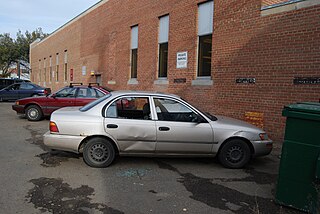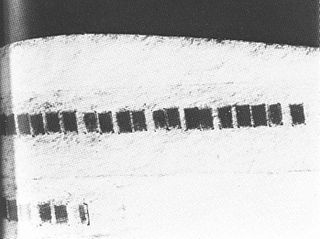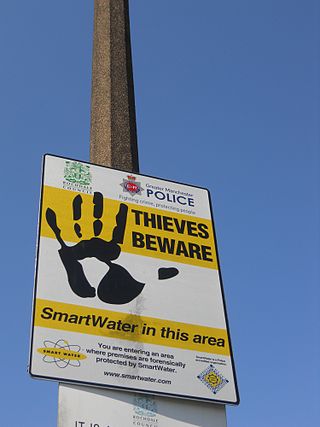


SelectaDNA is a forensic property marking system used as part of crime prevention strategies for businesses and residential properties. [1]



SelectaDNA is a forensic property marking system used as part of crime prevention strategies for businesses and residential properties. [1]
The SelectaDNA is a range of property and offender marking products combining synthetic DNA coding with microdot technology. Each SelectaDNA kit has sufficient fluid to mark up to 50-60 items or parts of an item such as a car. [2] Both the fluid and the microdots carry a unique code which the owner has to register in a database to which the police has access. In case of theft and the police recovering the item, it can be traced back to its owner. [3] A code found on an asset or person can be deciphered by a molecular genetic laboratory and identified back to a specific owner or location. The fluid is almost invisible, does no damage to the property and only becomes visible in ultraviolet light. [4] Also, dogs can be trained to sniff SelectaDNA marked items, as demonstrated by an initiative run by Wiltshire Police in cooperation with Search Dogs UK in July 2022. [5]
Every marking kit and spray canister has a unique forensic DNA signature which is a series of combinations of A (Adenine), C (Cytosine), G (Guanine) and T (Thymine). [6] The synthetic DNA used is short-chain, making it as robust as human DNA. [7]

The property marking kit includes a bottle of the marking fluid, application swap, 50 ID stickers, four 'thieves beware' stickers, a set-up membership card and instructions. [5] The 50 warning labels are to be attached to the marked items or properties to act as a deterrent for potential thieves or burglars. [2] Some UK police departments distribute the kits for free (e.g. the Cheshire Constabulary invested £170,000 to make the kits available to residents), [8] while others offer a discount. [5]
SelectaDNA is used to ‘tag’ valuable property, infrastructure, and criminals, and is available in a number of formats including vehicle marking solutions, Defiance Sprays to deter anti-social behavior and moped-enabled crime, SelectaDNA Trace for metal protection and Intruder Sprays for robbery prevention and transport protection. Formats for covert operations include transferable Gels, Grease and, Trespass Beads. SelectaDNA not only reduces crime but also enables Police to link criminals to crime scenes and secure convictions. [4] The Intruder Spray version can be used in instances where the perpetrator cannot be immediately caught or followed, e.g. sprayed by retail staff onto an intruder [9] or sprayed onto a leaving thief from a can located above the shop door.
Valuable items such as old cars, personal possessions such as laptops or mobile phones, farm equipment, contractor tools, bikes, can be marked with the solution. In the event that any items are stolen and recovered by Police, they are immediately traceable back to the owner. PCSP Chairman Alderman Robert Smith said: "Armagh, Banbridge and Craigavon PCSP is happy to be part of this pilot project and to be able to provide some support to local farmers protect their property using SelectaDNA." [10]
Notable users of the system include the National Health Service, the Royal Bank of Scotland, McDonald's, Post Office Limited, London School of Economics, Tesco, National Trust, Network Rail, [11] Lloyds Bank, Pandora, Chanel, G4S, Securitas, Louis Vuitton, Texaco, Shell plc, Bank of New Zealand, Los Angeles County Metropolitan Transportation Authority, [12] Three UK, [13] and many more.
Over 90% of UK police forces have used SelectaDNA in crime prevention schemes. [4]
In September 2022, Selectamark partnered with the UK National Business Crime Centre, seven police forces (Sussex Police, The Metropolitan Police, Hampshire Constabulary, Essex Police, West Midlands Police, Avon and Somerset Constabulary, and Greater Manchester Police) and Williams Trade Plumbing Supplies in a pilot programme to combat tool theft from commercial vehicles with the use of SelectaDNA property marking kits. [14] It is estimated that £83 million worth of tools have been stolen across England and Wales in 2020-23. The pilot will be followed up with a questionnaire to the owners of marked property to see if their tools have been stolen and if so, whether they have been recovered. [15]
'Operation Meteor', a scheme conducted by The Policing Institute for the Eastern Region (PIER) at Anglia Ruskin University (ARU) in collaboration with Essex Police, evaluating the effectiveness of property marking to reduce dwelling burglary, found no statistically significant results for all three deterrents (SelectaDNA, SmartWater and Immobilise) due to overall small number of burglaries between November 2019 and November 2020. Moreover, 68% of the participants took additional security measures such as installing locks, timer lights or locking windows when leaving the house or shutting the blinds which may have prevented burglaries. [16] Despite no reduction in crime numbers, the deterrent stickers (applied to 48% of properties where the products were distributed [16] ) may had worked as intended, deterring burglars from attacking properties marked with them and choosing other properties instead.
A 2018-2019 study based in an English town (West Bromwich near Birmingham) and three control areas evaluated the reduction in burglary numbers where the product was used was up to 83% in the 6 months following the marking kits distribution. The reduction was however short-lived: in the following 6-month period, burglary levels returned to the pre-treatment level (rose by 84%), despite the warning signs in the area being still in place. [17] Additionally, in the West Bromwich study, as a side effect of property protection, there was a 48% decrease in vehicle crimes and 46% reduction in criminal damage, which were sustained in the second 6-month post-intervention period, unlike the burglary levels that returned to the pre-intervention levels. Violent crime levels decreased slightly (by 22%). Those effects were achieved with 31% saturation rate (only 31% of the targeted residents accepted the marking kits and displayed the warning signs). The study concludes that warning sign display (street signs and window stickers) and kit distribution should be followed by police checks to ensure the items have been marked properly by the residents. Kit distribution and sign display also need to be done in parallel with other programmes, namely "increased resident vigilance, arrest and removal of offenders, difficulty in disposing of marked stolen property, and prosecution of the traders selling stolen goods." [17] Between April 2017 and April 2018, detection levels in England and Wales were 5.5% for burglary and 7% for robbery. [18] The West Bromwich study suggests that the details of prosecutions of offenders and sellers of stolen goods should be promoted to act as another deterrent. [17]
Similar numbers have been quoted in other case studies regarding vehicle theft (38%, 52%, up to 100% reduction [11] ).
In February 2022, SelectaDNA kits were distributed to more than 60 farms in South Lanarkshire in Scotland which were previously victims of machinery theft. The kits were funded by rural insurer NFU Mutual as part of its support for the Scottish Partnership Against Rural Crime (SPARC). Up until January 2023, no new thefts were reported since the distribution of the kits. [19] The National Farmers Union Mutual Insurance Society has provided additional funds to assist rolling out the initiative in other parts of Scotland. [20]
Selectamark Security Systems Plc won the Product Innovation Award at the UK Rail Industry Awards 2016 for the SelectaDNA product which has helped reduce metal theft on Network Rail lines. [23]
On 18 April 2023, Selectamark Security Systems Plc won the Security Innovation/Product of the Year Award from The Security Institute, the UK's largest professional membership body for security professionals, for their Personal Defence Spray. [9]
SelectaDNA won the Norwegian OSPA (Outstanding Security Performance Award) for Best New Security Product (Norway) in 2023. [24]
In 2023, Selectamark Security Systems won the SME of the Year award at British Security Awards presented by the British Security Industry Association. [14]
The system's supplier, Selectamark Security Systems Plc, is part of Secured by Design (SBD), the official UK Police security initiative that "works to improve the security of buildings and their immediate surroundings to provide safe places to live, work, shop and visit" [25] [26] and one of the two forensic deterrent suppliers approved by the Police under the Home Office Secured by Design Scheme (the other being SmartWater). [2]
Selectamark also owns bikeregister.com, [27] the largest bicycle register in the UK with over 1 million bikes registered, [14] and organises an annual Cycle Crime Conference supported by West Midlands Police and British Transport Police. [28] In July 2023, it hosted its 8th National Cycle Crime Conference. [14] The bike markings can be based on QR-code and printed numbers or the SelectaDNA liquid holding the Secured by Design accreditation. [29]
Until 2023, Selectamark has marked more than 100 million valuable items worldwide. [14]

Theft is the act of taking another person's property or services without that person's permission or consent with the intent to deprive the rightful owner of it. The word theft is also used as a synonym or informal shorthand term for some crimes against property, such as larceny, robbery, embezzlement, extortion, blackmail, or receiving stolen property. In some jurisdictions, theft is considered to be synonymous with larceny, while in others, theft is defined more narrowly. A person who engages in theft is known as a thief.
The Uniform Crime Reporting (UCR) program compiles official data on crime in the United States, published by the Federal Bureau of Investigation (FBI). UCR is "a nationwide, cooperative statistical effort of nearly 18,000 city, university and college, county, state, tribal, and federal law enforcement agencies voluntarily reporting data on crimes brought to their attention".

Motor vehicle theft or car theft is the criminal act of stealing or attempting to steal a motor vehicle.

A microdot is text or an image substantially reduced in size to prevent detection by unintended recipients. Microdots are normally circular and around 1 millimetre (0.039 in) in diameter but can be made into different shapes and sizes and made from various materials such as polyester or metal. The name comes from microdots often having been about the size and shape of a typographical dot, such as a period or the tittle of a lowercase i or j. Microdots are, fundamentally, a steganographic approach to message protection.
Laptop theft is a significant threat to users of laptop computers. Many methods to protect the data and to prevent theft have been developed, including alarms, laptop locks, and visual deterrents such as stickers or labels. Victims of laptop theft can lose hardware, software, and essential data that has not been backed up. Thieves also may have access to sensitive data and personal information. Some systems authorize access based on credentials stored on the laptop including MAC addresses, web cookies, cryptographic keys and stored passwords.
The Police National Computer (PNC) is a database used by law enforcement organisations across the United Kingdom and other non-law enforcement agencies. Originally developed in the early 1970s, PNC1 went 'live' in 1974, providing UK police forces with online access to the lost/stolen vehicle database. The vehicle owners application quickly followed, giving the police online access to the names/addresses of every vehicle owner in the UK.
Anti-theft systems protect valuables such as vehicles and personal property like wallets, phones, and jewelry. They are also used in retail settings to protect merchandise in the form of security tags and labels. Anti-theft systems include devices such as locks and keys, RFID tags, and GPS locators.

A bait car, also called a decoy car, hot car, or trap car, is a vehicle used by law enforcement agencies to capture car thieves or thieves who steal items from cars. The vehicles are modified with audio/video surveillance technology, and can be remotely monitored and controlled. Those set up to catch car thieves may include GPS tracking. A "kill switch" may be installed in the vehicle allowing police to remotely disable the engine and lock all doors, preventing escape. A car set up to catch thieves who steal items from cars may be disabled so that it cannot be started and have specially prepared "bait property".
In the United States, VIN etching is a countermeasure to motor vehicle theft, that involves etching a vehicle's VIN onto its windows to reduce the value of a stolen vehicle to thieves. The Federal Trade Commission includes VIN etching on a list of upsold services including extended warranties, service and maintenance plans, payment programs, guaranteed automobile or asset protection, emergency road service, and other theft protection devices, and warns consumers about the practice of upselling when buying a vehicle.

The Michigan State Police (MSP) is the state police agency for the U.S. state of Michigan. The MSP is a full-service law enforcement agency, with its sworn members having full police powers statewide.
The Royal Borough of Kensington and Chelsea Parks Police is a body of constables responsible for policing the parks and open spaces of the London Borough of Kensington and Chelsea. In 2013, it was merged with the Hammersmith and Fulham Parks Constabulary to form the Parks Police Service. Then, in July 2019 The Royal Borough of Kensington and Chelsea Parks Police moved away from The London Borough of Hammersmith and Fulham Parks Constabulary, once again becoming a single service.

SmartWater is a traceable liquid and forensic asset marking system (taggant), applied to items of value to identify thieves and deter theft. The liquid leaves a unique identifier, whose presence is invisible except under ultraviolet black light.
Property crime is a category of crime, usually involving private property, that includes, among other crimes, burglary, larceny, theft, motor vehicle theft, arson, shoplifting, and vandalism. Property crime is a crime to obtain money, property, or some other benefit. This may involve force, or the threat of force, in cases like robbery or extortion. Since these crimes are committed in order to enrich the perpetrator they are considered property crimes. Crimes against property are divided into two groups: destroyed property and stolen property. When property is destroyed, it could be called arson or vandalism. Examples of the act of stealing property is robbery or embezzlement.
A community service officer (CSO) provides support in crime prevention, investigation, and response where full police powers are unnecessary and assists police officers in upholding law and order.
The Johnson Gang is the collective name for a group of Romanichal criminals from Cheltenham, Gloucestershire, who specialised in stealing fine art and antiques from English country houses over a period of 20 years. The goods they stole are estimated to be worth between £30 million and £80 million. The gang were sentenced to a total of 49 years in prison in August 2008.
Akron Police Department is the primary municipal law enforcement agency for the city of Akron, Ohio, United States with 451 employees. The current Police Chief is Stephen L. Mylett.

Bike registries are databases of unique, identifying information about bicycles and their ownership. Most registration programs use the unique serial numbers which are permanently affixed to most bicycles during manufacture.
Market reduction approach (MRA) is an approach to reducing crime by reducing the opportunity for thieves to fence or resell what they have stolen.
An intelligent banknote neutralisation system (IBNS) is a security system which protects valuable items by rendering them unusable or easily detectable if an unauthorised individual tries to gain access to them. Dye packs are commonly used to safeguard currency against bank robberies in this manner; when such a pack is taken out of the bank, it releases an indelible dye that stains the money with a conspicuous bright color, making it easy to recognise as stolen. Bonding agents (glues) have been used more recently as alternative degradation agents.
Since 2014, the Metropolitan Police Service has identified a significant increase in moped enabled crimes. These are robberies committed by offenders riding mopeds and other vehicles such as motorised scooters. In 2017, moped crimes increased to almost 27,000 compared in 2011 with just 365 mopped crimes. Moped was reduced to 14,300 in 2018, higher than around 9,200 in 2019.